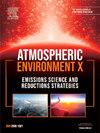Modelling the air quality impacts of a zero emission zone scenario in the city of Milan
IF 3.4
Q2 ENVIRONMENTAL SCIENCES
引用次数: 0
Abstract
One of the sustainable mobility policies aimed to reduce road traffic emissions in urban areas is the implementation of zero-emission zones (ZEZ) which are areas where only electric vehicles, pedestrians, and cyclists are allowed. The assessment of possible benefit of ZEZ on emissions, air quality and human health can be performed with a dedicated modelling chain. The goal of this work is to simulate a 2030 ZEZ mobility scenario in Milan city centre (Italy), introducing changes to the vehicle fleet composition within the ZEZ, as suggested by the Air Quality and Climate Plan of the municipality. Then we evaluated the benefits in terms of both air quality and citizens’ health. The assessment of the environmental and health effects is done thanks to a modelling suite composed of a road traffic, an emission, a hybrid air quality models, plus a fourth module for human health impacts. In this specific case study, the modelling chain is applied to the metropolitan city of Milan for the reference year 2017 first, and then for two hypothetical mobility scenarios referred to 2030: the temporal evolution of baseline simulation as planned by the NEC (National Emission reduction Commitments) directive and by local emission containment measures (BAS30) and the BAS30 scenario with the implementation of the mobility policy (ZEZ30). The impact of the policy can be inferred by comparing the two scenarios.
Road traffic emission in 2030 are expected to strongly decrease from the 2017 levels (−84% for NOx and −28% for PM2.5). The road traffic emission reduction introduced by the ZEZ30 scenario compared to the BAS30 scenario is high in the model cells contained within the ZEZ area (complete removal of NOx emissions and up to −45% PM2.5), but given the limited area of the ZEZ the citywide reduction of emissions is 2.24% for NOx and 0.91% for PM2.5. NO2 concentrations are expected to decrease of circa 54% inside the city of Milan under the BAS30 scenario compared with 2017 (35% for PM2.5). Again, the reduction introduced by the ZEZ are low and are mostly included within the ZEZ area (maximum 2% and 0.6 % for NO2 and PM2.5 respectively). Considering the ZEZ30 scenario, morbidity and mortality indicators are expected to decrease of 50% circa compared with 2017. In conclusion, the introduction of the ZEZ in 2030 is expected to have a marginal effect compared to the BAS30 scenario due to the limited spatial extent of the simulated ZEZ, the limited effect of electric vehicles on non-exhaust emissions, and the already strong emission reductions achieved using the projected 2030 vehicle fleet.
模拟米兰市零排放区情景对空气质量的影响
旨在减少城市道路交通排放的可持续交通政策之一是实施零排放区(ZEZ),即只允许电动汽车、行人和骑自行车的人通行的区域。可以通过专门的建模链来评估ZEZ对排放、空气质量和人类健康可能带来的好处。这项工作的目标是模拟2030年意大利米兰市中心的ZEZ交通情景,根据市政府的空气质量和气候计划,对ZEZ内的车队组成进行改变。然后,我们从空气质量和公民健康两方面评估了这些好处。对环境和健康影响的评估是通过一套模型来完成的,这套模型包括道路交通、排放、混合空气质量模型,以及关于人类健康影响的第四个模块。在这个具体的案例研究中,建模链首先应用于米兰大都市2017年的参考年,然后应用于2030年的两种假设的机动性情景:NEC(国家减排承诺)指令和当地排放控制措施(BAS30)计划的基线模拟的时间演变,以及实施机动性政策(ZEZ30)的BAS30情景。通过比较两种场景,可以推断出策略的影响。预计2030年道路交通排放将较2017年的水平大幅下降(氮氧化物为- 84%,PM2.5为- 28%)。与BAS30方案相比,ZEZ30方案引入的道路交通减排在ZEZ区域内的模型单元中很高(完全去除氮氧化物排放和高达- 45%的PM2.5),但鉴于ZEZ区域有限,全市范围内的氮氧化物减排为2.24%,PM2.5减排为0.91%。与2017年相比,在BAS30情景下,米兰市内的二氧化氮浓度预计将下降约54% (PM2.5下降35%)。同样,由ZEZ引入的减排也很低,而且主要包括在ZEZ区域内(NO2和PM2.5的最大降幅分别为2%和0.6%)。考虑ZEZ30情景,与2017年相比,发病率和死亡率指标预计将下降50%左右。综上所述,由于模拟ZEZ的空间范围有限,电动汽车对非废气排放的影响有限,以及使用预计的2030年车队已经实现了强有力的减排,因此,与BAS30情景相比,2030年引入ZEZ预计将产生边际效应。
本文章由计算机程序翻译,如有差异,请以英文原文为准。
求助全文
约1分钟内获得全文
求助全文
来源期刊

Atmospheric Environment: X
Environmental Science-Environmental Science (all)
CiteScore
8.00
自引率
0.00%
发文量
47
审稿时长
12 weeks
 求助内容:
求助内容: 应助结果提醒方式:
应助结果提醒方式:


